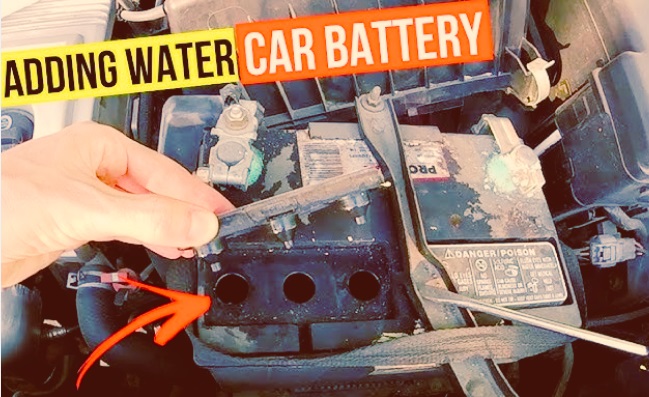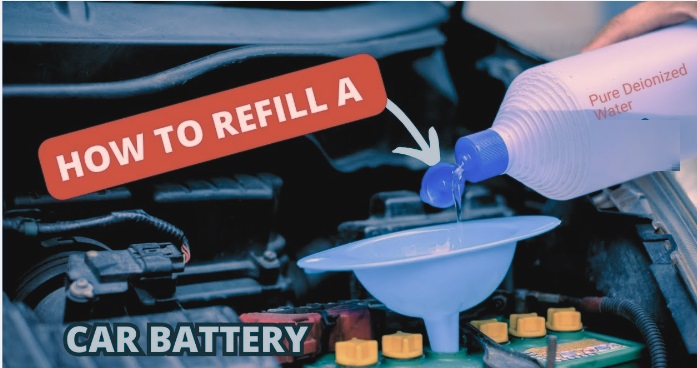Hello readers, welcome to the new post. Here we will discuss how to add water to a car battery. The water in lead-acid car batteries gets evaporates with time. This causes a decrease in the battery’s working power and also affects its working life. The battery level checking is needed for the accurate working of the car battery and the car. Here we will discuss how to add water to a car battery and which type of water is needed. So let’s get started with Filling Battery With Water: How to Add Water to a Car Battery.
What Is the Meaning of Battery With Water?
- It is a very common term used in chemistry called an electrolyte. This process is used to charge the accumulator. So this liquid exists in rechargeable batteries. The main work of the electrolyte solution is.
- In this solution, there are flat lead plates added. When charging is completed, the liquid gets heated.
- This solution is due to the heart being parted into two parts, oxygen gas and hydrogen gas, which will evaporate through vents. The sulfuric acid solution causes a chemical reaction between battery cells and produces electrons. These generated electrons get accumulated about the lead plates and cause the current to flow.
Which type of water should be used in a car battery?
- The point to be noticed is that not all types of water can be used for battery fill. The water coming from the tap has impurities and is not pure. Mineral water also causes chemical reactions in electrolysis.
- Qualified and tested deionized water is best to use. For more accuracy, use equipment to check the water quality. That is based on your budget.
- The best option is to use distilled water that is easy to afford and safely recharge the accumulators.
When Did the Battery Need Water?
- The best time to add water to the battery is when it is completely charged. The extra water can be added as possible. So try to avoid adding water when the battery is charging or discharging; it can be dangerous. Since during the charging process acid boils over, adding water will result in the fluid level increasing and causing splashing.
- For refilling frequency, it is based on the frequency of use and conditions of weather. Such as we will use a car occasionally. So add water once a week if you use the carafe regularly all day. Also in summer, the temperature is high, and the speed of water evaporation is fast.
How to Water a Battery in a Battery?
Follow these steps to refill your accumulator:
- Use safety instruments such as protective eyewear, gloves, etc.
- Disconnect power and clean the surrounding surfaces of the accumulators to avoid dust from getting in.
- Open the cover and check the liquid water in the accumulator. The battery terminals needed to be added in liquid.
- Check the water level and refill if it is missed and ensure that it covers battery plates.
- Try to avoid overfilling the battery with distilled water.
- Close the accumulators cover and other parts. Use a rag to swipe up spilled solutions. Check battery voltage and battery charges 2 days after filling.
Why Lead-Acid Batteries Need Water
- Lead-acid batteries produce current roughly using the phenomenon of electrochemical reaction between lead plates and electrolytes.
- The electrolyte is a mixture of water and sulfuric acid.
- Flooded batteries generate current through the reaction of liquid electrolytes and lead plates. And water saves battery active material when it produces power.
- Without water active materials will oxidize and the battery will lose power. So lead acid needed water.
Why Do Lead-Acid Batteries Lose Water?
- As the battery is charged, electricity flows through the electrolyte. Due to that, water split into oxygen and hydrogen. Batteries lose water since during charging currents split water. Some hydrogen is then released due to a process called gassing.
- This process also loses battery water. Based on the type of acid in the battery, it is not needed to add water to it. Such as the batteries that needed less maintenance, such as AGM batteries, which did not need regular water addition. Since these batteries are sealed.
- Sealed batteries save water losses by stopping hydrogen from releasing. Sealing helps atoms to reform and prevents water losses.
- With that, vented batteries help gases to release that result in water losses.
Why maintain forklift battery water levels?
If the water level decreases, very low battery lead plates oxidize. That causes problems like
- Reduces the power of the battery
- Not charge the battery completely
- Decreases battery working life
Safety Tips for Watering Batteries
- The addition of water in a lead-acid battery can be a difficult process.
- Due to the chemicals in the battery, there is a chance of damage. So chemicals can cause bad effects like
- It causes acid splashing, corrosion, skin burns, and inhalation of toxic gases such as hydrogen.
How to Check the Battery’s Water Level
Try to check the water level in the battery manual or use a battery level indicator. Here is the process explained for a manual water level check.
- Remove the call cap on the battery cell.
- Check if the electrolyte is over the upper part of the protective splash plate. If it is like than not needed water.
- If the electrolyte level is below the splash plate and some plates can be seen, it means the battery needs water.
Should Water Be Added to a Battery Before or After Charging?
- Just add water when the battery is fully charged, which helps it to expand.
- With that, only add water when the battery is cooled. It is the time when the battery water level is at its high point after expansion.
How Much Water Should We Add to a Battery?
Add water until the electrolyte level is 1/8″ over the plates or about ¾″ ”below the top of the cell.
What to Do if We Add Too Much Water to the Battery
- Try to avoid overfilling batteries. During water addition to a lead-acid battery, enough space is needed for fluids to expand when the battery is charging or in use.
- If not so, the battery will bubble over, overflow, and spill solution.
- It can also cause damage if the solution makes a connection with the skin.
FAQs
How do you add water to a car battery?
- Use distilled or deionized water on top of battery plates. Add batteries on complete change. When getting charged, check the water level. If more water is required, add it to 1/8” below the fill well.
How do you top up a car battery with water?
- Use distilled water and do not use tap water. If the battery is discharged at the time, top it up so that the plates are just covered. If the battery is completely charged, top up to about 1 cm above the plates.
When should I add water to my car battery?
- If water is over the plates before the water level is showing the tops of the plates. Varying the battery warms the water, so if added larger before starting to charge, the water will be pushed out from hydrogen gas bubbles and make a mess on top of the battery.
Do all car batteries need water added?
- Not all car batteries needed water to be checked or refilled. Ensure that the battery can be opened and serviced. Maintenance-free batteries are completely sealed and must not be opened. Batteries that needed regular water service have service instructions and warning labels.







